The Geological History of the Chang’e-5 Sample Return Region
Abstract
:1. Introduction
2. Data and Method
3. Results
3.1. General Topography of CE-5 Sample Return Region
3.2. Composition of the Study Area
3.2.1. Chemical Composition
3.2.2. Mineralogy Composition
3.3. Mare Units and Surface Age
3.3.1. Definition of Geological Units
3.3.2. Surface Ages of the Mare Units in the CE-5 Region
4. Discussion
4.1. Volcanism in the CE-5 Landing Area
4.2. Tectonism in the CE-5 Sample Return Region
5. Conclusions
Supplementary Materials
Author Contributions
Funding
Institutional Review Board Statement
Informed Consent Statement
Data Availability Statement
Acknowledgments
Conflicts of Interest
References
- Wang, J.; Zhang, Y.; Di, K.; Chen, M.; Duan, J.; Kong, J.; Xie, J.; Liu, Z.; Wan, W.; Rong, Z.; et al. Localization of the Chang’e-5 lander using Radio-Tracking and Image-Based methods. Remote Sens. 2021, 13, 590. [Google Scholar] [CrossRef]
- Qiao, L.; Chen, J.; Xu, L.; Wan, S.; Cao, H.; Li, B.; Ling, Z. Geology of the Chang’e-5 landing site: Constraints on the sources of samples returned from a young nearside mare. Icarus 2021, 364, 114480. [Google Scholar] [CrossRef]
- Turkevich, A.L.; Franzgrote, E.J.; Patterson, J.H. Chemical analysis of the moon at the surveyor V landing site. Science 1967, 158, 635–637. [Google Scholar] [CrossRef] [PubMed]
- Reeves, R. Exploring the moon. In The Superpower Space Race: An Explosive Rivalry through the Solar System; Springer: Boston, MA, USA, 1994; pp. 101–130. [Google Scholar]
- Turkevich, A.L. Comparison of the analytical results from the surveyor, Apollo, and Luna missions. Earth Moon Planets 1972, 5, 411–421. [Google Scholar] [CrossRef]
- Liu, J.; Zeng, X.; Li, C.; Ren, X.; Yan, W.; Tan, X.; Zhang, X.; Chen, W.; Zuo, W.; Liu, Y.; et al. Landing site selection and overview of China’s lunar landing missions. Space Sci. Rev. 2021, 217, 1–25. [Google Scholar] [CrossRef]
- Li, C.; Liu, D.; Liu, B.; Ren, X.; Liu, J.; He, Z.; Zuo, W.; Zeng, X.; Xu, R.; Tan, X.; et al. Chang’E-4 initial spectroscopic identification of lunar far-side mantle-derived materials. Nat. Cell Biol. 2019, 569, 378–382. [Google Scholar] [CrossRef]
- Xiao, L.; Zhu, P.; Fang, G.; Xiao, Z.; Zou, Y.; Zhao, J.; Zhao, N.; Yuan, Y.; Qiao, L.; Zhang, X.; et al. A young multilayered terrane of the northern Mare Imbrium revealed by Chang’E-3 mission. Science 2015, 347, 1226–1229. [Google Scholar] [CrossRef]
- Jolliff, B.L.; Gillis, J.J.; Haskin, L.A.; Korotev, R.L.; Wieczorek, M. Major lunar crustal terranes: Surface expressions and crust-mantle origins. J. Geophys. Res. Space Phys. 2000, 105, 4197–4216. [Google Scholar] [CrossRef] [Green Version]
- Qian, Y.; Xiao, L.; Head, J.W.; van der Bogert, C.H.; Hiesinger, H.; Wilson, L. Young lunar mare basalts in the Chang’e-5 sample return region, northern Oceanus Procellarum. Earth Planet. Sci. Lett. 2021, 555, 116702. [Google Scholar] [CrossRef]
- Qian, Y.Q.; Xiao, L.; Zhao, S.Y.; Zhao, J.N.; Huang, J.; Flahaut, J.; Martinot, M.; Head, J.W.; Hiesinger, H.; Wang, G.X. Geology and Scientific Significance of the Rümker Region in Northern Oceanus Procellarum: China’s Chang’E-5 landing region. J. Geophys. Res. Planets 2018, 123, 1407–1430. [Google Scholar] [CrossRef] [Green Version]
- Hiesinger, H.; Head, J.W.; Wolf, U.; Jaumann, R.; Neukum, G. Ages and stratigraphy of lunar mare basalts in Mare Frigoris and other nearside maria based on crater size-frequency distribution measurements. J. Geophys. Res. Space Phys. 2010, 115, 115. [Google Scholar] [CrossRef] [Green Version]
- Jia, M.; Yue, Z.; Di, K.; Liu, B.; Liu, J.; Michael, G. A catalogue of impact craters larger than 200 m and surface age analysis in the Chang’e-5 landing area. Earth Planet. Sci. Lett. 2020, 541, 116272. [Google Scholar] [CrossRef]
- Zhao, J.; Xiao, L.; Qiao, L.; Glotch, T.D.; Huang, Q. The mons rümker volcanic complex of the moon: A candidate landing site for the Chang’E-5 mission. J. Geophys. Res. Planets 2017, 122, 1419–1442. [Google Scholar] [CrossRef]
- Yue, Z.; Li, W.; Di, K.; Liu, Z.; Liu, J. Global mapping and analysis of lunar wrinkle ridges. J. Geophys. Res. Planets 2015, 120, 978–994. [Google Scholar] [CrossRef] [Green Version]
- Hurwitz, D.M.; Head, J.W.; Hiesinger, H. Lunar sinuous rilles: Distribution, characteristics, and implications for their origin. Planet. Space Sci. 2013, 79–80, 1–38. [Google Scholar] [CrossRef]
- Hulme, G. A review of lava flow processes related to the formation of lunar sinuous rilles. Surv. Geophys. 1982, 5, 245–279. [Google Scholar] [CrossRef]
- Whitford-Stark, J.L.; Head, J.W. The Procellarum volcanic complexes-Contrasting styles of volcanism. In Lunar and Planetary Science Conference Proceedings; Lunar and Planetary Institute: Houston, TX, USA, 1977. [Google Scholar]
- Gong, S.; Wieczorek, M.A.; Nimmo, F.; Kiefer, W.; Head, J.W.; Huang, C.; Smith, D.E.; Zuber, M.T. Thicknesses of mare basalts on the Moon from gravity and topography. J. Geophys. Res. Planets 2016, 121, 854–870. [Google Scholar] [CrossRef]
- Haruyama, J.; Matsunaga, T.; Ohtake, M.; Morota, T.; Honda, C.; Yokota, Y.; Torii, M.; Ogawa, Y. LISM Working group global lunar-surface mapping experiment using the Lunar Imager/Spectrometer on SELENE. Earth Planets Space 2008, 60, 243–255. [Google Scholar] [CrossRef] [Green Version]
- Boardman, J.W.; Pieters, C.M.; Green, R.O.; Lundeen, S.R.; Varanasi, P.; Nettles, J.; Petro, N.; Isaacson, P.; Besse, S.; Taylor, L.A. Measuring moonlight: An overview of the spatial properties, lunar coverage, selenolocation, and related Level 1B products of the Moon Mineralogy Mapper. J. Geophys. Res. Space Phys. 2011, 116. [Google Scholar] [CrossRef] [Green Version]
- Green, R.O.; Pieters, C.; Mouroulis, P.; Eastwood, M.; Boardman, J.; Glavich, T.; Isaacson, P.; Annadurai, M.; Besse, S.; Barr, D.; et al. The Moon Mineralogy Mapper (M3) imaging spectrometer for lunar science: Instrument description, calibration, on-orbit measurements, science data calibration and on-orbit validation. J. Geophys. Res. Space Phys. 2011, 116. [Google Scholar] [CrossRef] [Green Version]
- Clark, R.N.; Pieters, C.M.; Green, R.O.; Boardman, J.W.; Petro, N.E. Thermal removal from near-infrared imaging spectroscopy data of the Moon. J. Geophys. Res. Space Phys. 2011, 116, 116. [Google Scholar] [CrossRef] [Green Version]
- Besse, S.; Sunshine, J.; Staid, M.; Boardman, J.; Pieters, C.; Guasqui, P.; Malaret, E.; McLaughlin, S.; Yokota, Y.; Li, J.-Y. A visible and near-infrared photometric correction for Moon Mineralogy Mapper (M3). Icarus 2013, 222, 229–242. [Google Scholar] [CrossRef]
- Lemelin, M.; Lucey, P.G.; Miljković, K.; Gaddis, L.R.; Hare, T.; Ohtake, M. The compositions of the lunar crust and upper mantle: Spectral analysis of the inner rings of lunar impact basins. Planet. Space Sci. 2019, 165, 230–243. [Google Scholar] [CrossRef]
- Otake, H.; Ohtake, M.; Hirata, N. Lunar iron and titanium abundance algorithms based on SELENE (Kaguya) Multiband Imager data. In Proceedings of the Lunar and Planetary Science Conference, Woodlands, TX, USA, 19–23 March 2012; p. 1905. [Google Scholar]
- Lemelin, M.; Lucey, P.G.; Song, E.; Taylor, G.J. Lunar central peak mineralogy and iron content using the Kaguya Multiband Imager: Reassessment of the compositional structure of the lunar crust. J. Geophys. Res. Planets 2015, 120, 869–887. [Google Scholar] [CrossRef]
- Pieters, C.M.; Staid, M.I.; Fischer, E.M.; Tompkins, S.; He, G. A sharper view of impact craters from clementine data. Science 1994, 266, 1844–1848. [Google Scholar] [CrossRef] [Green Version]
- Pieters, C.M.; Boardman, J.; Buratti, B.; Chatterjee, A.; Clark, R.; Glavich, T.; Green, R.; Head, J., III; Isaacson, P.; Malaret, E.J.C.S. The Moon mineralogy mapper (M3) on chandrayaan-1. Curr. Sci. 2009, 96, 500–505. [Google Scholar]
- Qiao, L.; Xiao, L.; Zhao, J.; Huang, Q.; Haruyama, J. Geological features and evolution history of Sinus Iridum, the Moon. Planet. Space Sci. 2014, 101, 37–52. [Google Scholar] [CrossRef]
- Besse, S.; Sunshine, J.M.; Staid, M.I.; Petro, N.E.; Boardman, J.W.; Green, R.O.; Head, J.W.; Isaacson, P.J.; Mustard, J.F.; Pieters, C.M. Compositional variability of the Marius Hills volcanic complex from the Moon Mineralogy Mapper (M3). J. Geophys. Res. Space Phys. 2011, 116. [Google Scholar] [CrossRef] [Green Version]
- Staid, M.I.; Pieters, C.M.; Besse, S.; Boardman, J.; Dhingra, D.; Green, R.; Head, J.W.; Isaacson, P.; Klima, R.; Kramer, G.; et al. The mineralogy of late stage lunar volcanism as observed by the Moon Mineralogy Mapper on Chandrayaan-1. J. Geophys. Res. Space Phys. 2011, 116. [Google Scholar] [CrossRef]
- Mustard, J.F.; Pieters, C.M.; Isaacson, P.J.; Head, J.W.; Besse, S.; Clark, R.N.; Klima, R.; Petro, N.; Staid, M.I.; Sunshine, J.; et al. Compositional diversity and geologic insights of the Aristarchus crater from Moon Mineralogy Mapper data. J. Geophys. Res. Space Phys. 2011, 116. [Google Scholar] [CrossRef] [Green Version]
- Cheek, L.C.; Hanna, K.L.D.; Pieters, C.M.; Head, J.W.; Whitten, J.L. The distribution and purity of anorthosite across the Orientale basin: New perspectives from Moon Mineralogy Mapper data. J. Geophys. Res. Planets 2013, 118, 1805–1820. [Google Scholar] [CrossRef]
- Taylor, G.J. Lunar Rocks; Cambridge University Press: Cambridge, UK, 1991. [Google Scholar]
- Pieters, C.M.; Fischer, E.M.; Rode, O.; Basu, A. Optical effects of space weathering: The role of the finest fraction. J. Geophys. Res. Space Phys. 1993, 98, 20817–20824. [Google Scholar] [CrossRef] [Green Version]
- Hiesinger, H.; Jaumann, R.; Neukum, G.; Head, J.W. Ages of mare basalts on the lunar nearside. J. Geophys. Res. Space Phys. 2000, 105, 29239–29275. [Google Scholar] [CrossRef]
- Page, N. (LAC-25) Geologic Map of the Cassini Quadrangle of the Moon; USGS: Reston, VA, USA, 1970. [Google Scholar] [CrossRef]
- Snyder, J.P. Map Projections--A Working Manual; US Government Printing Office: Washington, DC, USA, 1987; Volume 1395. [Google Scholar]
- Kneissl, T.; van Gasselt, S.; Neukum, G. Map-projection-independent crater size-frequency determination in GIS environments—New software tool for ArcGIS. Planet. Space Sci. 2011, 59, 1243–1254. [Google Scholar] [CrossRef]
- Stöffler, D.; Ryder, G. Stratigraphy and isotope ages of lunar geologic units: Chronological standard for the inner solar system. Space Sci. Rev. 2001, 96, 9–54. [Google Scholar] [CrossRef]
- Liu, J.; Guo, D. Lunar geological timescale. In Encyclopedia of Lunar Science; Springer: Singapore, 2018; pp. 1–3. [Google Scholar]
- Giguere, T.A.; Hawke, B.R.; Gillis-Davis, J.J.; Lemelin, M.; Boyce, J.M.; Trang, D.; Lawrence, S.J.; Stopar, J.D.; Campbell, B.A.; Gaddis, L.R.; et al. Volcanic Processes in the Gassendi Region of the Moon. J. Geophys. Res. Planets 2020, 125. [Google Scholar] [CrossRef]
- Kramer, G.Y.; Jolliff, B.L.; Neal, C.R. Distinguishing high-alumina mare basalts using Clementine UVVIS and Lunar Prospector GRS data: Mare Moscoviense and Mare Nectaris. J. Geophys. Res. Space Phys. 2008, 113, 113. [Google Scholar] [CrossRef]
- Korotev, R.L.; Jolliff, B.L.; Zeigler, R.A.; Gillis, J.J.; Haskin, L.A. Feldspathic lunar meteorites and their implications for compositional remote sensing of the lunar surface and the composition of the lunar crust. Geochim. et Cosmochim. Acta 2003, 67, 4895–4923. [Google Scholar] [CrossRef]
- Xu, Z.; Guo, D.; Liu, J. Maria basalts chronology of the Chang’E-5 sampling site. Remote. Sens. 2021, 13, 1515. [Google Scholar] [CrossRef]
- Lucey, P.G.; Blewett, D.T.; Jolliff, B.L. Lunar iron and titanium abundance algorithms based on final processing of Clementine ultraviolet-visible images. J. Geophys. Res. Space Phys. 2000, 105, 20297–20305. [Google Scholar] [CrossRef]
- Sato, H.; Robinson, M.S.; Lawrence, S.J.; Denevi, B.W.; Hapke, B.; Jolliff, B.L.; Hiesinger, H. Lunar mare TiO2 abundances estimated from UV/Vis reflectance. Icarus 2017, 296, 216–238. [Google Scholar] [CrossRef]
- Pieters, C. Mare basalt types on the front side of the moon-A summary of spectral reflectance data. In Proceedings of the Lunar and Planetary Science Conference Proceedings, Huston, TX, USA, 13–17 March 1978; pp. 2825–2849. [Google Scholar]
- Yue, Z.; Michael, G.; Di, K.; Liu, J. Global survey of lunar wrinkle ridge formation times. Earth Planet. Sci. Lett. 2017, 477, 14–20. [Google Scholar] [CrossRef]
- Moore, H.; Boyce, J.; Hahn, D. Small impact craters in the lunar regolith—Their morphologies, relative ages, and rates of formation. Moon Planets 1980, 23, 231–252. [Google Scholar] [CrossRef]
- Williams, N.; Iii, J.F.B.; Watters, T.R.; Banks, M.E.; Daud, K.; French, R.A. Evidence for recent and ancient faulting at Mare Frigoris and implications for lunar tectonic evolution. Icarus 2019, 326, 151–161. [Google Scholar] [CrossRef]
- Daket, Y.; Yamaji, A.; Sato, K.; Haruyama, J.; Morota, T.; Ohtake, M.; Matsunaga, T. Tectonic evolution of northwestern Imbrium of the Moon that lasted in the Copernican Period. Earth Planets Space 2016, 68, 68. [Google Scholar] [CrossRef] [Green Version]
- Watters, T.R.; Johnson, C.L. Lunar tectonics. Planet. Tecton. 2010, 11, 121–182. [Google Scholar]
- Watters, T.R.; Robinson, M.S.; Banks, M.E.; Tran, T.; Denevi, B. Recent extensional tectonics on the Moon revealed by the Lunar reconnaissance orbiter camera. Nat. Geosci. 2012, 5, 181–185. [Google Scholar] [CrossRef]


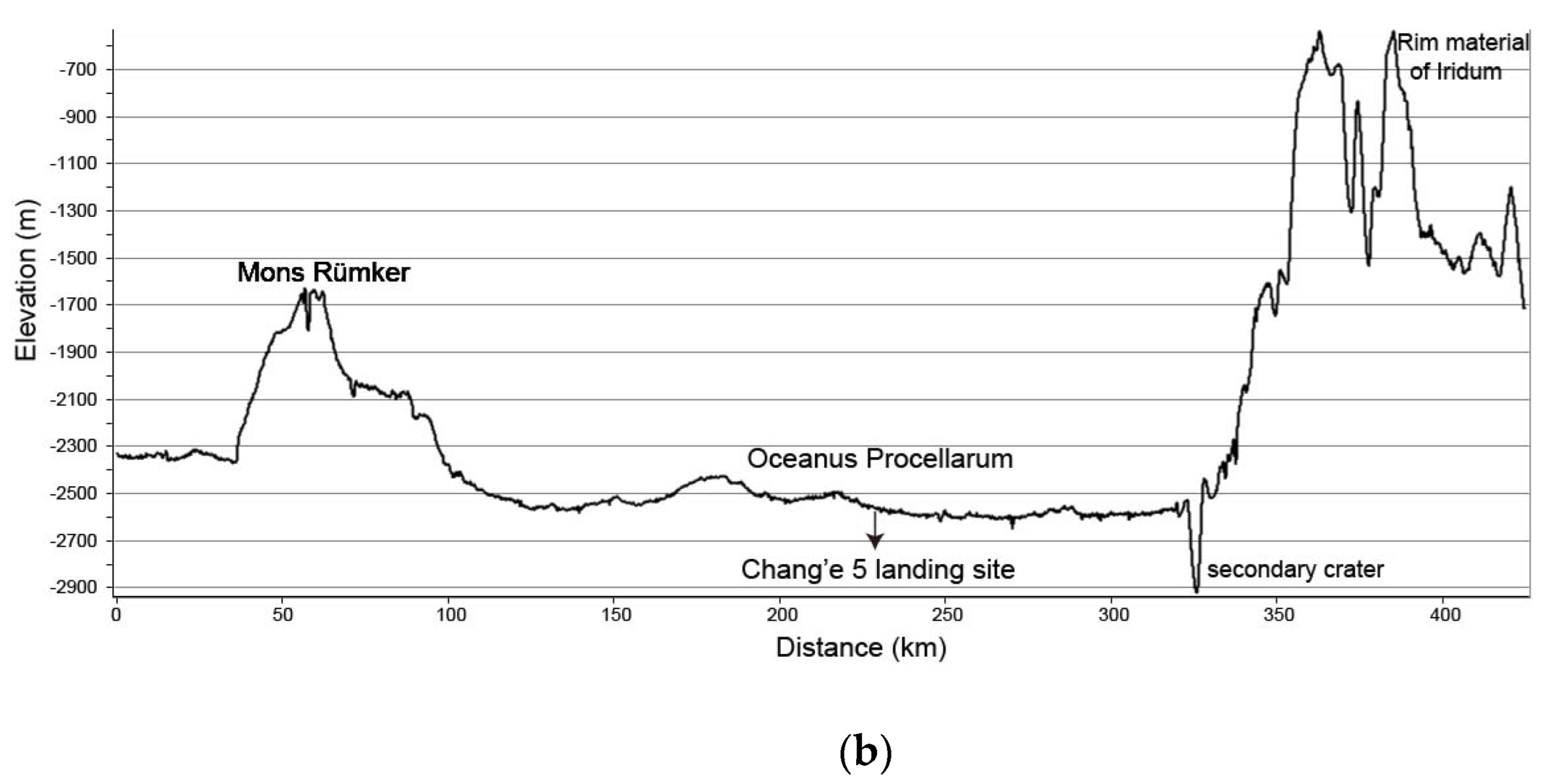
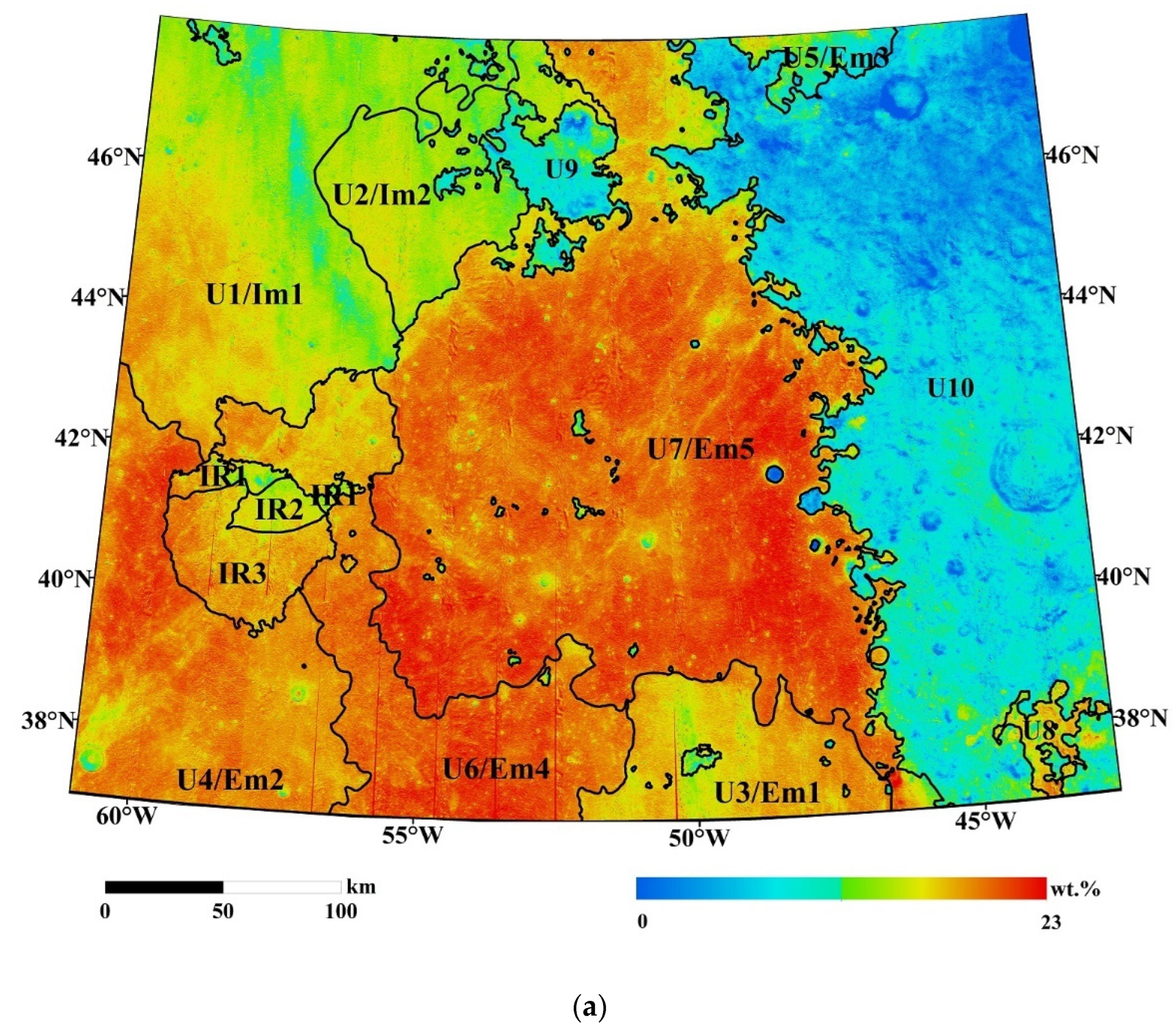

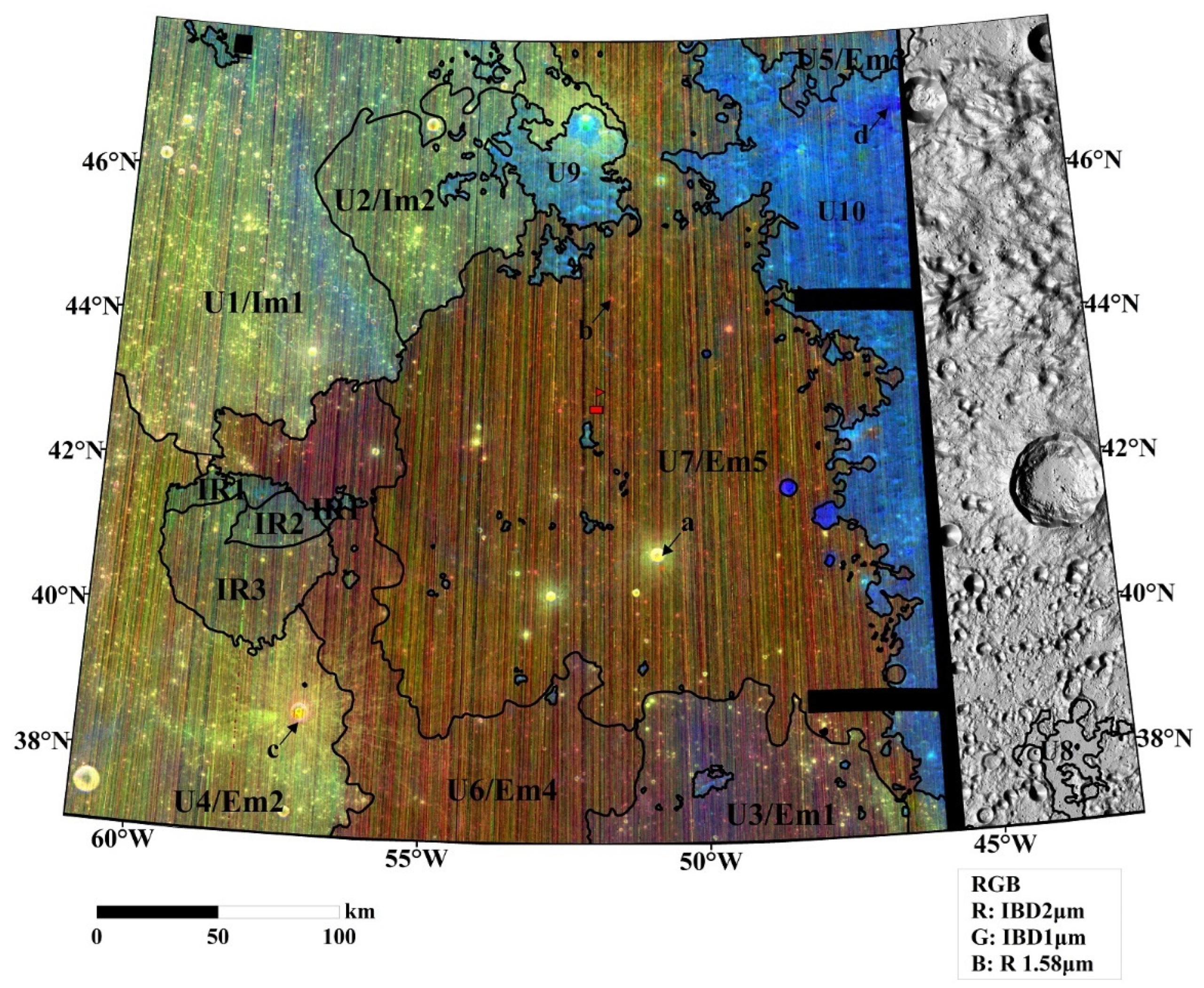

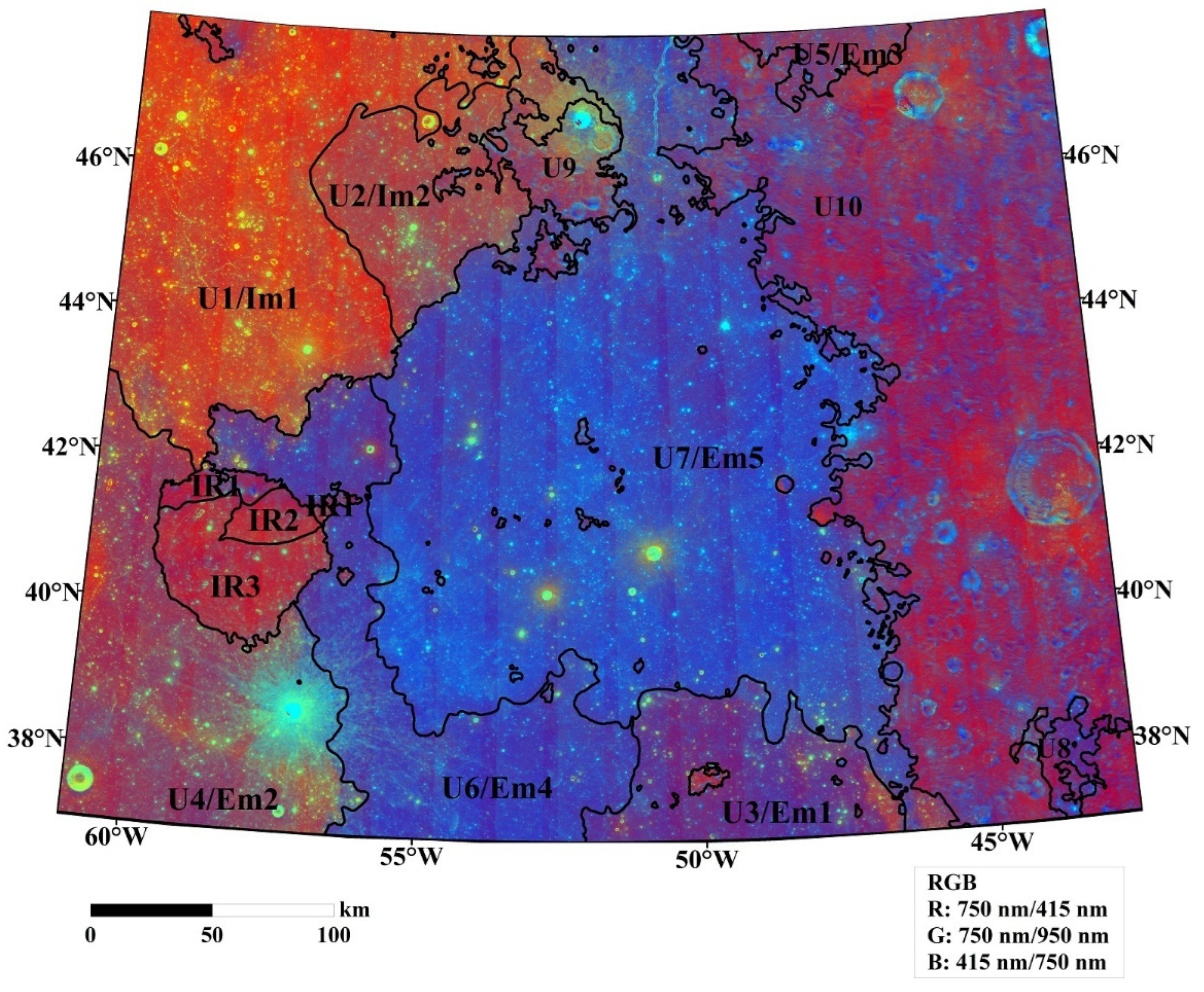


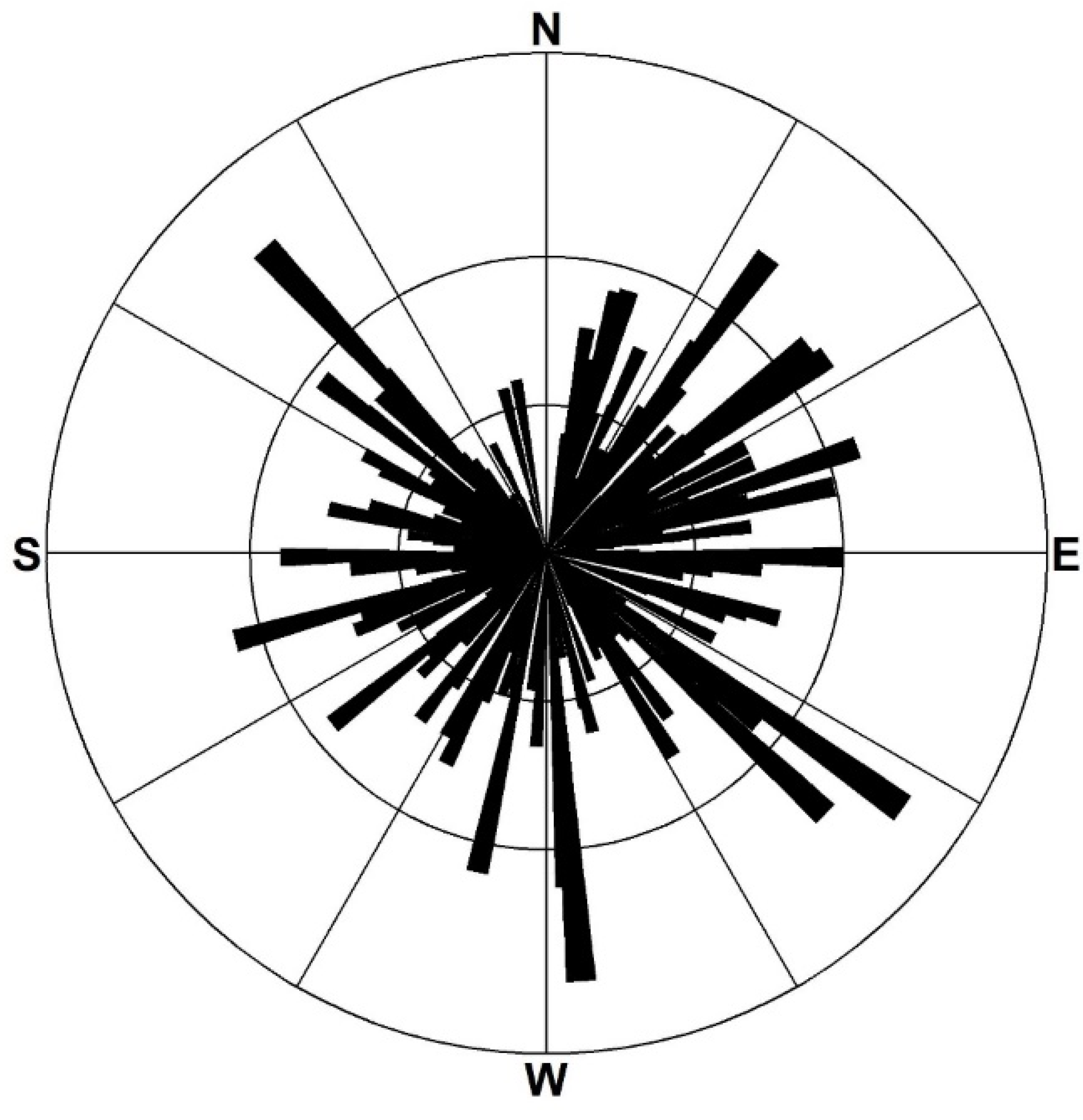
| Units | FeO 1,2 (wt.%) | TiO2 1,2 (wt.%) |
|---|---|---|
| Mare northern Oceanus Procellarum | 16.11 (1.46) | 3.24 (1.81) |
| The rim of the Iridum crater | 10.9 (1.63) | 1.08 (0.53) |
| Units | Surface Age (Ga) | Error (Ga) | Stratigraphy | Hiesinger (2000) | Qian (2018) | Jia (2020) |
|---|---|---|---|---|---|---|
| U1 | 3.36 | +0.03/−0.03 | Im1 | 3.4 | 3.39 | 3.27 |
| U2 | 3.25 | +0.04/−0.05 | Im2 | 3.4 | 3.16 | 3.23 |
| U3 | 2.45 | +0.09/−0.09 | Em1 | 2.1 | 1.70 | |
| U4 | 2.33 | +0.13/−0.13 | Em2 | 2.30 | ||
| U5 | 1.94 | +0.12/−0.12 | Em3 | 1.5 | 2.54 | |
| U6 | 1.39 | +0.07/−0.07 | Em4 | 1.51 | 2.07 | |
| U7 | 1.22 | +0.03/−0.03 | Em5 | 1.3 | 1.21 | |
| IR1 | 3.71 1 | +0.04/−0.05 1 | IR1 | |||
| IR2 | 3.58 1 | +0.03/−0.04 1 | IR2 | |||
| IR3 | 3.51 1 | +0.04/−0.06 1 | IR3 |
| Unit (wt.%) | FeO 1,2 (wt.%) | TiO2 1,2 (wt.%) |
|---|---|---|
| U1/Im1 | 14.70 (1.06) | 0.99 (0.35) |
| U2/Im2 | 14.43 (0.75) | 1.31 (0.37) |
| U3/Em1 | 15.88 (0.82) | 2.99 (0.67) |
| U4/Em2 | 16.66 (0.74) | 2.33 (0.59) |
| U5//Em3 | 12.82 (1.39) | 1.46 (0.55) |
| U6/Em4 | 16.82 (0.98) | 4.25 (1.03) |
| U7/Em5 | 16.85 (1.04) | 4.66 (1.25) |
| IR1 | 15.19 (1.14) | 1.95 (0.52) |
| IR2 | 15.01 (0.72) | 1.51 (0.38) |
| IR3 | 16.25 (0.74) | 1.85 (0.44) |
Publisher’s Note: MDPI stays neutral with regard to jurisdictional claims in published maps and institutional affiliations. |
© 2021 by the authors. Licensee MDPI, Basel, Switzerland. This article is an open access article distributed under the terms and conditions of the Creative Commons Attribution (CC BY) license (https://creativecommons.org/licenses/by/4.0/).
Share and Cite
Deng, J.; Cheng, W.; Jiao, Y.; Liu, J.; Chen, J.; Wang, B. The Geological History of the Chang’e-5 Sample Return Region. Remote Sens. 2021, 13, 4679. https://doi.org/10.3390/rs13224679
Deng J, Cheng W, Jiao Y, Liu J, Chen J, Wang B. The Geological History of the Chang’e-5 Sample Return Region. Remote Sensing. 2021; 13(22):4679. https://doi.org/10.3390/rs13224679
Chicago/Turabian StyleDeng, Jiayin, Weiming Cheng, Yimeng Jiao, Jianzhong Liu, Jianping Chen, and Baixue Wang. 2021. "The Geological History of the Chang’e-5 Sample Return Region" Remote Sensing 13, no. 22: 4679. https://doi.org/10.3390/rs13224679
APA StyleDeng, J., Cheng, W., Jiao, Y., Liu, J., Chen, J., & Wang, B. (2021). The Geological History of the Chang’e-5 Sample Return Region. Remote Sensing, 13(22), 4679. https://doi.org/10.3390/rs13224679









